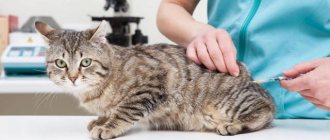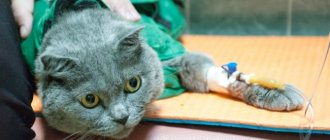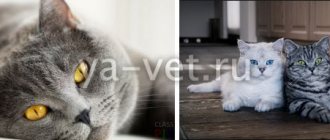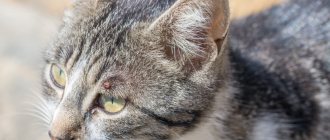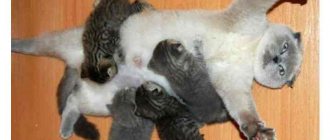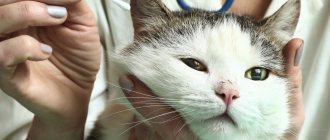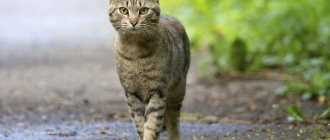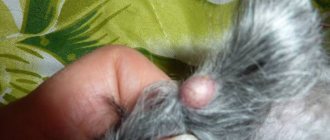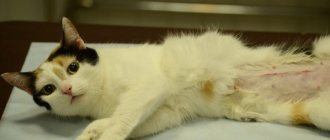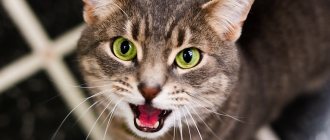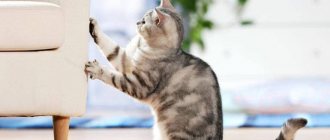Behavior of cats when sick
A change in the cat's behavior should alert the owner
Each pet has its own character and norm of behavior. The owner can easily describe his furry friend: he is playful, or maybe a sleepyhead, affectionate, or bites and does not allow himself to be handled. But how can you tell if your cat is sick? First of all, the pet’s behavior will change from active to passive, from affectionate to aggressive, and this will be the first bell.
When an animal becomes ill, the following changes in its behavior can be identified:
- Decreased appetite or lack thereof;
- A decrease in body weight or, conversely, a sharp increase;
- Drowsiness, lethargy, apathy;
- Aggression, anxiety, harshness and nervousness in movements;
- The animal is hiding;
- Coordination of movements is impaired.
Physical signs:
- Skin redness, peeling, bald spots;
- Discharge from the eyes, nose, ears;
- Sneezing, coughing, difficulty breathing;
- Vomiting, diarrhea, constipation, difficulty urinating;
- Discharge mixed with blood;
- Increased or decreased temperature;
- Hair loss;
- Rapid breathing;
- Bad breath.
The presence of one or a combination of several symptoms is a reason to consult a doctor.
Cats are patient animals and, as a rule, they express their poor health by decreasing activity and going to secluded places, and not by meowing.
Mood and sociability
Cats, like people, have different personalities. Some are ready to do anything to get their owner to pick them up, caress them and scratch them behind the ears, while others are so self-sufficient that they only occasionally allow them to touch the royal person. How can you tell if your cat is sick based on her mood? Again, record any changes in one direction or another.
It often happens that when the owner realizes that the cat is sick
, the stage of the disease is already quite advanced.
The thing is that cats tend to hide their painful condition. Often, when a cat is sick
, it may generally hide from people. Most diseases are best treated at their initial stage.
You are the only one who sees your pet every day, so your decision determines when the animal will be examined by a veterinarian. Don’t ignore what your pet is trying to tell you in his own way! Here are some clues that will help you understand that something is wrong with your cat.
Character of bowel movements
Frequent stomach upset may be a sign of illness
A change in stool in an animal is not always a sign of disease, but such a symptom cannot be ignored. If this is accompanied by fever, vomiting, or blood in the stool, you should immediately consult a veterinarian.
Diarrhea - loose stools, can be the cause of a disease of the digestive system in an animal, associated with large loss of fluid and painful sensations in the abdomen.
Symptoms:
- Frequent urge to go to the toilet - more than three times a day;
- Watery stools;
- Incontinence (the cat did not have time to reach the tray);
- Light-colored stool with shades of yellow and green;
- Blood in the stool or its black color indicates damage to the animal’s internal organs;
- Vomiting, lethargy, loss of appetite.
Such symptoms may be present in the case of poor nutrition, poisoning, or a change in diet, but may also indicate the presence of diseases.
- E. coli infection;
- bacterial infections;
- parasitic lesions of the animal’s body (worms, worms, roundworms);
- diabetes;
- metabolic disorder;
- fungal infections;
- oncology;
- diseases of the urinary system;
- green color in the stool indicates liver disease;
Bloody or black stool indicates internal bleeding
Types of diarrhea and color of stool:
- loose stools accompanied by vomiting may indicate poisoning of the animal. If diarrhea is accompanied by white foamy vomiting, the cat may have leukemia or other viral diseases;
- bowel movements with mucus indicate a disease of the large intestine;
- the presence of mucus in stool indicates damage to the large intestine;
- the presence of blood means a disease of the digestive system or the presence of parasites, and possible damage to the internal organs of the animal.
- yellow color of stool may indicate that food is not digested;
- black color - indicates the presence of internal hemorrhage, but may indicate excess meat products in the diet;
- green color indicates that the animal has eaten spoiled food;
- white color of stool indicates problems in the biliary tract;
- orange – intoxication of the body.
If diarrhea is regular and is accompanied by a general weakening of the body, vomiting, pain, and also has black, orange colors or blood impurities, contacting a veterinarian is mandatory.
The appetite of a sick cat
Refusal to eat animals can cause various diseases
An animal's refusal to eat is a cause for concern. If refusal to eat is accompanied by diarrhea, vomiting, increased thirst, sneezing, or weight loss, this may indicate a systemic disease in the pet.
Diseases that can be caused by refusal to eat:
- Viral infections are accompanied by sneezing, discharge from the nose, eyes, vomiting and diarrhea.
- Gastritis, pancreatitis are accompanied by vomiting and diarrhea;
- Inflammation of the kidneys - refusal to eat is associated with increased temperature, thirst, frequent urination;
- Liver disease , accompanied by vomiting and diarrhea;
- Kidney failure is associated with thirst, weight loss, and hematemesis;
- Diabetes mellitus, in which the animal not only refuses to eat, but also its thirst increases, the smell of its breath changes, and vomiting appears;
- Inflammation of the uterus is accompanied by white-bloody discharge from the genital tract; the cat's temperature, thirst, and abdomen increase.
- Oncology provokes weight loss and vomiting.
Lack of appetite in an animal for more than a day, which is accompanied by vomiting, diarrhea and various types of discharge, is a reason to immediately contact a veterinary clinic.
Also, an animal may refuse to eat temporarily, during stress, estrus, a change in diet, or colds. These reasons are not critical. Therefore, it is necessary to monitor the animal’s behavior and, if additional symptoms or systematic refusal are detected, take timely measures to preserve the animal’s health and life.
Prevention of diseases in cats
Preventing illnesses in cats is not that difficult. One of the mandatory preventive measures is periodic visits to the veterinarian. It is believed that the examination should be carried out once every quarter or at least every six months.
Cats should be well-balanced, with sufficient vitamins and minerals. Vitamins of group B, A, C, E, D, K are necessary. But it is advisable that they enter the body with food.
Important! Hypervitaminosis is no less harmful. There is no need to buy vitamins for your animal every time you visit a pet store. A deficiency of vitamins is also fraught with disorders in the body. Only a specialist should prescribe vitamin and mineral complexes.
You should immediately contact the clinic if you have the following symptoms:
- , especially if the cat is taken outside or allowed on;
- traces of bites from another animal;
- seals on the body;
- the cat refuses food and drink for several days;
- signs ;
- body temperature has changed sharply;
- there is a suspicion of injury.
It is advisable for animals that go out on their own to purchase special flea collars.
If any deviations in the behavior or condition of the cat appear, it is better to immediately show it to a doctor. After all, they often turn to a specialist in the final stages, when nothing can be done.
The recommendations will help cat lovers pay attention to homeless animals that also need human help and participation. This will also help to identify individuals infected, for example, with rabies, and take preventive measures in time.
Temperature readings
A wet and cool nose is a sign of a healthy cat.
Everyone knows that a cat’s temperature can be understood by its nose: if it is wet and cold, it means the pet is healthy, if it is dry and warm, the temperature is elevated. But this is not an entirely correct measurement of a pet’s body temperature and is not decisive. A dry and warm nose is not always associated with the presence of a disease in an animal.
Without using a thermometer, the temperature of an animal can also be determined by the following signs:
- Hot ears and heated fur;
- Refusal to eat;
- Increased thirst;
- Dilated pupils;
- Lethargy and apathy;
- Fear of people;
- Chills;
- Vomiting, diarrhea;
- Discharge from the ears, eyes and nose;
- Pallor of mucous membranes.
The normal body temperature of an animal is from 37.5 to 39ﹾC. Kittens have a lower temperature and can range from 35.1 to 36.1˚C. Several factors influence temperature, including the age and condition of the animal. After sleep, the temperature is reduced, and with overeating, heat and stress it can increase.
A deviation in the temperature of a healthy adult pet by several degrees is a reason for the presence of a disease. Temperatures below 37.5 or above 40 ﹾC require the attention of a doctor.
How to measure temperature: The animal's temperature is measured rectally. It is advisable to use an electronic thermometer, as it takes less time to determine the temperature, and the animal is quite impatient.
It is advisable to measure the cat’s temperature either in a standing position or lying on its side.
It is advisable to fix the cat in position; you can wrap it in a towel if it is especially active and aggressive. If the cat is calm, you can simply lay it on its side and stroke it soothingly. The cat must not curl up into a ball or press its tail.
Before inserting the thermometer, it must be lubricated with cream or Vaseline. Then, using rotational movements, insert the tip of the thermometer into the animal’s anus 2-3 cm - no more. The main thing is not to make sudden movements or scare the animal. After the procedure, the animal must be petted and rewarded with something tasty for its patience.
The electronic thermometer should be held for 1-3 minutes or until a characteristic signal occurs.
We should measure 5-7 minutes with a mercury thermometer. When using a special rectal thermometer, it will make a characteristic sound when the measurement ends. The thermometer is small and should be immersed shallowly; its use will save the nerves of the animal and the owner.
The thermometer must subsequently be washed and wiped with alcohol.
The causes of low temperature may be hypothermia, shock from injury, after anesthesia or taking medications that lower blood pressure.
Cats with cardiovascular disease may also have a low temperature.
An elevated temperature may indicate the following diseases:
- Infectious;
- Poisoning and intoxication;
- Oncology;
- Endocrine diseases;
- Metabolic disorders and reactions to medications.
A temperature above 40-41 degrees is a serious symptom of the disease and requires urgent action, even in the absence of accompanying symptoms.
Respiratory status, shortness of breath and cough
Cough may be caused by foreign bodies entering the respiratory tract or illness
You can tell if a cat is feeling unwell either by its breathing or by the presence of shortness of breath or coughing.
A cough is formed by contraction of the muscles of the respiratory tract and is a loud and sharp exhalation through the mouth.
The causes of coughing in an animal can be various, from foreign bodies entering the respiratory tract and a reaction to caustic substances, to diseases.
Such diseases may be:
- Respiratory infections such as laryngitis, tracheitis, bronchitis, pneumonia, which are accompanied by sneezing, discharge from the eyes, and fever.
- Asthma , which is accompanied by shortness of breath and wheezing;
- Viral and allergic diseases associated with microbes, bacteria, and the presence of parasites (worms). If the animal is not treated for worms, they subsequently enter the stomach from the intestines, which is accompanied by vomiting and coughing. You should be especially wary if the animal simultaneously refuses to eat, vomiting, lethargy and weakness appear.
- Oncological diseases of the respiratory system.
- Heart diseases , in which the animal stretches its neck and tongue when coughing.
These diseases show the following symptoms:
- Cough, both dry and wet, with sputum production;
- Difficulty breathing, which is accompanied by wheezing, whistling;
- Decreased appetite, lethargy, drowsiness;
- Shortness of breath;
- Discharge from the nose, from the mouth;
- Inflammation of the mucous membranes;
- Fever due to infectious diseases.
Treatment of diseases of this nature is prescribed by a veterinarian.
Shortness of breath in a cat
Shortness of breath in an animal can be caused by active play, heat, motion sickness during travel, but it can also be a cause of illness.
- Diseases of the respiratory tract in the form of obstruction of the nasal passages or the presence of polyps in the throat, pulmonary edema or asthma and other diseases;
- Cardiovascular diseases;
- Diseases of the nervous system: brain tumor, disruption of the intercostal muscles;
- Blood disorders such as anemia.
Shortness of breath manifests itself in the form of wheezing or whistling sounds; the animal does not fully inhale air. The animal often opens its mouth and swallows air with it, while taking unnatural poses. The mucous membranes of the mouth take on a pale appearance, and the animal often drinks water. The cat's breathing is difficult.
In addition, unpleasant breathing may indicate the presence of diseases in an animal.
A healthy cat does not have bad breath
The smell of rot can be the cause of inflammatory processes in the cat’s oral cavity (teeth, gums), especially during teething, if there are remains of baby teeth.
The cause may be diseases of the digestive system, such as the stomach, intestines, and digestive glands.
An unpleasant odor from a cat’s mouth, similar to ammonia, may indicate kidney disease, and the smell of acetone may indicate diabetes. Also, another specific smell from the mouth may indicate the presence of cancer or parasites.
Signs of disease in kittens
Some people specifically select sick animals to give them love and care. But when it comes to breeders who want to engage in breeding, it is extremely important that the individual is healthy.
The following signs indicate illness:
- tilting the head to the side or forward;
- purulent, swelling and redness of the eyelids;
- open nictitating membrane (third eyelid), squint;
- inflammatory process on the skin of the nostrils, discharge from the nasal passages;
- irritated skin of the ears, the presence of gray or brown crumbs in them;
- swelling, redness or poverty of the gums, ulcers on the surface of the oral mucosa;
- lack of activity and playfulness inherent in cats of this age;
- bloating, hollowness, pain in the abdomen;
- dullness of the coat, general unkemptness, ;
- symptoms of gastrointestinal disorders - vomiting, loose stools;
- respiratory phenomena - sneezing.
Video - How to choose a healthy kitten
Features of discharge
It is important to monitor your pet for foreign secretions
An animal’s discharge can be of a different nature, in different places, and some of them give reason to be wary and take timely measures.
Discharge from the genital tract
Discharge during pregnancy and after childbirth is considered normal and is mostly brownish in color.
Discharges can be: scanty and abundant, cloudy and almost transparent, thick or liquid, have colors: white, cream, gray, mixed with pus and blood, with a putrid or sour odor.
Pathological discharge may be evidence of diseases such as tumors of the genital tract, infectious diseases of the genital organs.
Symptoms:
- Frequent and copious discharge from the genital tract – the cat often licks itself;
- Friction of the lower body against objects, fabrics;
- Frequent urination or, conversely, difficulty;
- Apathy, lethargy, low mood;
- Thirst, chills;
- Lack of appetite;
- Bloating.
Frequent licking of the genitals may indicate heavy discharge
Diseases:
- Pyometra is the presence of pus in the uterus caused by bacteria, which can lead to the formation of cysts. In this case, the discharge is cloudy-white and hair loss is detected in the abdominal area.
- Endometritis is an inflammation of the uterine mucosa. With this disease, the temperature rises, inflammation of the genital organs, and pain in the abdominal area occur.
An animal may have bloody discharge during estrus; if she has not had a mating process, this is considered normal.
Discharge from eyes, nose and ears.
Healthy cats have a clear look and no discharge
In some cat breeds, brown discharge from the eyes is the norm (Persian, Scottish, British breeds), which is due to the structure of the skull. And in some cases, discharge may be a sign of infectious and viral diseases.
Increased lacrimation, clear and then purulent discharge from the eyes indicate the presence of eye diseases, such as cataracts, glaucoma, mycoplasmosis, as well as obstruction of the nasolacrimal duct.
Eye diseases are accompanied by inflammation of the mucous membrane, redness of the eye, and the presence of a crust under the eye.
Nasal discharge: In cats, the nose acts as a filter and small brown crusts under the nose are not something dangerous, but rather the result of filtering the inhaled air.
Cat nasal discharge can cause illness
However, if there is excessive sneezing and discharge accompanied by difficulty breathing, this may indicate serious illnesses, from rhinitis to oncology.
Viral infections, such as herpes, rhinitis, are accompanied by thick and mucous discharge from the nose, lack of appetite, fever, and lacrimation. Delayed treatment can cause pneumonia.
Nasal discharge can be caused by growths and tumors in the nasal cavity or fungal infections such as cryptococcosis and aspergillosis. At the same time, the discharge is thick and purulent.
The cause of clear, thin discharge and excessive sneezing may be due to an allergy or a foreign body entering the nasal passages.
Discharge from the ears may be caused by a mite-like condition called ear scabies. The mite infects the ear canal, eardrum and the inside of the ear.
Healthy cats' ears should be clean, not painful, and free of discharge.
Symptoms:
- Brown discharge from the ears;
- Frequent shaking of the head;
- Frequent ear scratching.
Another common ear disease in cats is otitis media, which results in inflammation of the ear canal. It appears as:
- unpleasant odor from the animal’s ears;
- Discharge from the ears can be either dark brown or purulent.
- frequent scratching;
- inflammation of the ear canal;
- pain when touching the ears;
- bowing the head to one side;
- irritability of the animal.
You should not try to cure the animal yourself. If these reasons occur, you should consult a doctor.
Signs of cat love
Representatives of cats express emotions each in their own way. Some signs of affection are identified at first sight, others need to be learned to notice. The main thing is to listen carefully and observe the behavior of your pet.
Representatives of felines express emotions each in their own way
The brought kitten begins to look closely at all the members of the new family and choose its owner. He may love the rest or be neutral towards him, but one person will be his master. It is not necessarily the one who gives the food who cleans the tray.
Manifestations of cat sympathy are divided into several groups:
- Sound signs: meowing and purring.
- Visual: prolonged eye-to-eye contact, squinting.
- Behavioral: meets, gets underfoot, sleeps next to the owner, raises its tail up, lies with its belly up, tramples on different parts of the human body. Hugs with paws, licks, bites, caresses. Shares prey, toys, shows patience, stays nearby if the owner is sick.
Cat meows and purrs
Cats can be silent or talkative. Silent pets rarely make any sounds. They meow for attention only to express a request or demand.
Talkative cats accompany any action with various variants of meowing: from the banal “meow” to the dissatisfied “myr”, not wanting to be ignored, asking for affection.
By the intonation of sounds, you can determine what your pet is expressing:
- complaint;
- requirement;
- discontent;
- fear;
- love and tenderness.
Be sure to read:
Why cats hiss: the main reasons, what to do, how to calm them down when they are aggressive towards a certain person
When a cat purrs, she shares her good mood, love, and thanks for the food she liked . When a pet squints its eyes with pleasure and licks its hands, there is no doubt about its affection.
When a cat purrs, she shares her good mood, love, and thanks for the food she liked.
The sounds made by cats have a wide range of sounds: from a calm, quiet purr to a loud, eloquent purr. This is how pets show affection towards family members. When a pet purrs while lying next to you, sitting on your lap, it expresses its friendliness and tenderness.
If purring resembles a hum going throughout the body, then this is a clear expression of cat love.
Proposal to divide the spoils
Cats are predatory animals, hunters. Chasing toys, beams of laser keychains, birds, mice, they satisfy their hunting instincts.
Having caught a mouse or bird, the pet brings the catch home to “feed” the person less successful in the hunt, expressing gratitude. A caring animal must be praised, otherwise offense is guaranteed.
There are breeds of cats that take water treatments with great pleasure, but in general, animals do not like water.
Many owners can tell stories of how a cat approached a person lying in the bathtub, looked with eyes full of horror and screamed heart-rendingly, afraid that he would drown. A caring attitude is shown towards the entire family.
Biting and rubbing
A caring attitude is shown to the entire family.
The pet climbed onto its knees, stood on its hind legs, hugged the neck with its front paws and bit the cheek, nose or lips - this is the highest manifestation of love. Cats only bite their owner. The remaining members of the family receive such tenderness extremely rarely.
When an animal rubs its muzzle against its legs, arms, or face, this does not mean that it marks a person as property.
On the animal’s head there are secretory glands that secrete substances that make it possible to mark members of its pride with an individual scent.
Such signs of cat tenderness, even bites, are evidence of love, gratitude and trust in the people around you.
Be sure to read:
Why cats wash themselves often: 7 main reasons, what to do if they stop licking their fur
Sleeping with the owner
Each pet has its own place in the room to sleep and rest. A loving cat will definitely come to sleep with its owner at night, after going around all the family members and purring them a good night song. This is a show of affection.
Trampling on different parts of the owner's body
An accurate sign of a cat's affection is “stomping,” when the cat shifts from paw to paw and slightly extends its claws. This behavior is developed at an early age, when kittens stimulate the flow of milk from the mother cat.
An accurate sign of a cat's affection is “stomping,” when the cat shifts from paw to paw and slightly extends its claws.
Adult cats demonstrate this feeling of absolute security; they trust the owner as a mother cat.
Licking
Licking the owner's face, hands, other parts of the body or hair does not indicate that the cat has decided to wash the dirty dog or do his hair in accordance with the cat's taste - this is the highest level of expression of his love and devotion.
Seals lick babies, thinking they are kittens. In the first days of the birth of a child in the family, parents need to be careful: animals are no strangers to feelings of jealousy. The pet must get used to the new family member and understand that he is still loved.
Jealousy can manifest itself towards a wife, husband, children, a computer, a book, or any hobby that takes up the time of family members.
Tail quivering and pistol tail
The tail of animals is the main organ for displaying emotions. He may twitch sharply from side to side, threaten his upper part irritably, or lie still. If a cat lying next to you twitches the very tip of its tail, it expresses its favor and gratitude.
If there is no trust between a cat and a person, he will not allow you to touch the tail - he will definitely bite. When a cat follows its owner with its tail raised like a pistol, it expects attention. The slightly curved tip indicates joy from the presence of the owner.
Be sure to read:
Why cats leave home to die: 5 reasons, where they go, how they behave before death
Rear end demonstration
When the pet turns its back and raises its tail, it offers to sniff itself. This is how cats behave with each other. This is not an insult, but a sign of respect and trust. It can also mean protecting the owner from danger.
Cat's gaze
Cats cannot stand staring for a long time, perceiving it as a threat.
Cats only make eye contact with people they like.
Cats only make eye contact with people they like. If the gaze is accompanied by a leisurely blink, there is no doubt that the cat’s complete trust has been won. This behavior means “blowing a cat kiss.”
What does fur and skin look like?
A healthy cat has bright and shiny fur
Thick, shiny fur is a sign of animal health. Hair loss can be part of natural physiological processes such as shedding, pregnancy, hormonal imbalance, and can also occur as a result of poor diet or stress.
But the most dangerous are skin diseases of the animal, causing hair loss.
Skin diseases can manifest as severe itching and bald spots. Such symptoms and diseases can be caused by:
- fleas that haunt the animal and cause constant severe itching. The cat independently combs out or gnaws out areas of the skin that are areas of itching, resulting in the formation of bald spots and wounds. The cat loses body weight and becomes irritable;
- Mites, areas of baldness usually occur on the muzzle, ears and front paws. Cats scratch themselves, and the wounds can fester. In addition, mites can cause a skin condition that appears as reddish, bare patches of skin;
- allergic reactions caused by medications and household products. Red skin rashes appear, the cat experiences itching and anxiety;
- lichen, expressed as redness on the skin with scales. The cat is constantly itching, the size of the spots and their number increases ;
- other skin diseases.
Skin diseases in cats
Hair loss and skin manifestations can also be the cause of internal diseases of the animal:
- the abundance of worms gives the coat a pale color, hairs fall out, as the parasites disrupt metabolism;
- disruption of the thyroid gland or hormonal imbalance, which is expressed, among other things, in a feeling of thirst, increased urination, and an enlarged abdomen.
Skin diseases, as a rule, are treated easily and quickly, but to make an accurate diagnosis you need to contact a veterinary clinic.
Body mass
Many cat owners are amused when they are “in the body.” But excess weight is harmful to animals as well as to people, since it causes problems with the musculoskeletal system, heart, and blood vessels.
Specific body weight indicators depend on the breed. The following signs indicate excess weight:
- it is difficult to feel the ribs and spine;
- the waist is invisible;
- In the area of the sternum, on the back, when palpated, fat is felt.
With obesity, these signs intensify, in addition, the volume in the abdominal area greatly increases.
It is also dangerous in cats. Thinness occurs due to helminthic infestations, cancer, and digestive problems. The fact that a cat has lost a lot of weight can be determined visually:
- there is no fat layer at all in the chest area;
- the muscles are almost invisible;
- In smooth-haired cats, pelvic bones, ribs and other parts of the skeleton are visible under the skin.
What is the condition of the mouth and eyes?
The animal's oral cavity should have a pinkish color, without plaque or ulcers.
When an animal is healthy, there is no unpleasant odor from its mouth, the gums are not inflamed, the oral cavity is pink, without plaque or pale spots. The eyes should be clean, clear and shiny.
An ulcer in the mouth, both on the tongue and on the palate, may indicate an infectious disease. The disease is accompanied by discharge from the eyes, fever, and copious amounts of saliva. With calicivirus during complicated periods, symptoms worsen, with vomiting, shortness of breath, and diarrhea. Without timely treatment, the animal will die.
With viral diseases, the tongue and oral cavity of the animal turns pale and becomes covered with a pale membrane.
If the animal's eyes become pale, a cloudy membrane appears, or discharge from the eyes, both transparent and purulent, indicates an eye disease of the animal and other internal diseases associated with disruption of the blood vessels of the brain, nervous system and the functioning of the nasal excretory system.
It is necessary to monitor the shine of not only the coat, but also the eyes.
What kind of nose does a sick animal have?
The animal's nose should be moist and cool and of a natural color
Veterinarians believe that you can tell if a cat is sick or not by looking at its nose. A healthy cat's nose should be moist and cool. It becomes dry for a while after sleep or active play, or heat.
If an animal has a constantly dry and warm nose, this is a sign of concern. If sores or peeling appear on the nose, the animal may have a skin disease and should be shown to a doctor. A healthy nose should not have any ulcers or sores, as well as thick discharge of various colors.
The color of the nose depends on the color of the animal; the presence of age spots on the nose is not a disease. However, if a cat’s nose suddenly changes color to yellow, this may indicate liver disease; if it begins to acquire a bluish tint, this indicates heart disease, and a red nose may indicate mechanical damage.
Symptoms You Shouldn't Ignore
An animal's illness is primarily manifested by changes in behavior
First of all, with any change in the animal’s behavior, you need to be alert and take them into account, and then monitor its behavior.
You should immediately contact a veterinarian if:
- regular vomiting and diarrhea;
- presence of blood or black color in the stool, which indicates internal bleeding;
- profuse salivation, discharge of various colors (yellow, purulent) from the eyes, nose, ears, genital tract;
- convulsions, chills;
- weight loss and appetite;
- active and nervous scratching leading to bald spots and ulcers on the skin;
- excessive hair loss and bald areas;
- painful reaction when touching an animal (stomach, ears).
Important! A timely visit to a veterinarian and making an accurate diagnosis will increase the animal’s chances of a speedy recovery. Procrastination and inattention to the animal can cost it its life.
What cat diseases are dangerous to humans?
A number of cat diseases are dangerous for humans
Some diseases affect not only a person’s “younger brothers,” but also the person himself, which can be transmitted by a pet. In addition, pets can be carriers of diseases dangerous to humans without being sick with them themselves.
A person can become infected with the following diseases:
- Rabies . In the animal it manifests itself as excessive salivation, aggressive or overly affectionate behavior, and convulsions. In humans, it is expressed by fever, insomnia and anxiety, paralysis, painful perception of light, obsessive fear. The disease is fatal to both animals and humans and is transmitted through a bite.
- Ringworm , which is expressed by red spots on the human body;
- Worms and other parasites , manifested in shortness of breath, abdominal pain, blood in the stool;
- Toxoplasmosis , symptoms are subtle, both in animals and in humans;
- Tularemia , an infectious disease that, in both humans and animals, is expressed in the form of fever, intoxication, oral ulcers, hepatitis, and damage to the lymph nodes. Transmitted by airborne droplets.
- Pasteurellosis, a rare infectious disease that can be transmitted through cuts and cat bites. A person develops inflammation and blisters in the wound area, fever, cough, and pulmonary edema. The animal feels a decrease in appetite, rapid and difficult breathing, a cough with sputum, and pulmonary edema.
- Felinosis or cat scratch disease is transmitted to humans through scratches and is infectious in nature. In humans, the scratch site becomes inflamed, then the lymph nodes become enlarged, and the body temperature rises. Animals are carriers and the disease does not manifest itself in them.
In order not to become infected with various diseases from an animal, you must follow preventive measures:
- Wash your hands after contact with animals and before eating;
- It is necessary to treat the animal every six months for parasites and receive the necessary vaccinations;
- Do not allow the animal to hunt rodents that can be carriers of diseases;
- Use proper fresh food;
- If you notice symptoms in an animal or person, consult a doctor.
Changing your cat's behavior
An increase in the duration of sleep in a cat does not necessarily indicate illness - perhaps the cat is tired. However, if the long sleep is accompanied by other symptoms or the cat seems weak, you should visit the clinic.
Monitor how the cat goes to the toilet - whether the duration and frequency changes, whether the cat experiences difficulties. An alarming symptom is the appearance of blood in the stool or urine. If your cat is unsuccessful in using the litter box, there may be a urinary tract problem.
Also watch for changes in your pet's appetite. A cat may not touch food all day due to poor health or stealing food on the side. A cat's sudden desire to eat more may also indicate illness. Problems with eating food should also be a concern.
Take your cat to the vet if she is constantly thirsty or shows signs of dehydration. To check your cat for dehydration, you should gently pull the fold of skin between the shoulder blades - normally it should quickly return to its place.
If the cat sleeps a lot, does not want to eat, and the fur has become dull, check the cat for fever. A temperature above 39.2 degrees is considered elevated.
Where can you go if your pet is sick?
You can call a doctor at home or consult by phone
If you notice changes in your animal's behavior and symptoms that may indicate serious illness, you should contact your veterinarian.
You can call a doctor at home, you can consult by phone, or you can make an online appointment. Experienced specialists will be able to determine the animal’s disease based on its symptoms and prescribe treatment. To do this, you do not need to go to the clinic and further disturb your pet. If tests are needed to clarify the diagnosis, your doctor will tell you. At best, a trip to the clinic can be avoided.
A healthy cat always has a clear look and a playful disposition.
The owner’s main task is to pay attention to the pet’s behavior, timely detection of symptoms or changes in behavior that may indicate the presence of a disease. Early detection of the disease, its diagnosis and treatment will keep the animal healthy and prolong its life.
Signs of pain
The sensation of pain affects the cat's behavior, which changes before physical symptoms appear.
Know your cat's temperament and behavior. How does she behave in ordinary situations, how energetic is she, what is her gait, appetite, sleep pattern, how does she behave when thirsty. The slightest change in behavior is a sign that the animal is sick or in pain. The cat will not tell you that it is in pain, but you will probably notice its unusual behavior.
How to make a bed or house yourself?
Changing your cat's daily habits does not always promote aging. Age is not a disease, but older cats suffer more pain.
